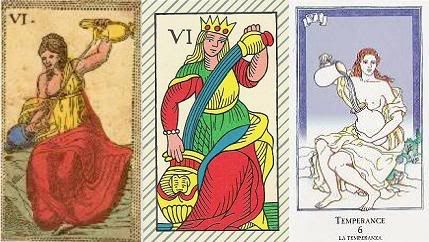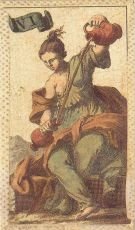full deck
(A foreword - mind you, we want to focus on the use and study of minchiate but I'm also throwing in more of the historical and artistic background so as to add a bit more to the postings so I apologize if all this seems a bit pedantic.)
Historic Background
The "Temperance" of the minchiate is a very traditional depiction of temerance or of "temperantia"Lat. or symbol of moderation that evolved from the Greek "Sophrosyne", The cardinal virtue of moderation, self-knowledge, and self-restraint. The Delphic code with its cautionary maxims, “Know thyself,” “Nothing in excess,” “Think mortal thoughts,” expressed the chief implications of "sophrosyne" in the archaic age. (see Temperance and the Canon of the Cardinal Virtues
In the earliest extant example, the Vivian Bible (843-51), all four virtues are half-figures (two male, two female), holding palm branches and stretching out their hands towards the central figure, King David. In other manuscripts of the ninth century Prudentia invariably holds a book, Fortitudo arms and armor, Iustitia a set of scales, and Temperantia a torch and jug. The early ideas of "temperance" seem to refer to a more mundane habit of adding water to one's wine, so as to not get drunk and to encourage a personal sense of moderation.
Previous to the Italian artist Giotto, the cardinal virtues had been depicted only rarely in Italian art, although Romanesque mosaic pavements in Pavia and Cremona show scenes of the psychomachia (depiction of vices being triumphed over by a corresponding virtue) involving other sets of virtues. Very nearly unique is a portrayal of the cardinal virtues through genre-scenes, in the choir mosaics of San Savino in Piacenza (1107), where a duel suggests Fortitude; a king pronouncing judgment, Justice; a game of chess, Prudence; and a scene of revelry, Tem- perance. The mosaic in the Cupola of the Ascension in St. Mark's, Venice, dating from ca. 1200, includes the cardinal virtues in a group of sixteen, which reflect the influence of Byzantine processional scenes by way of Ravenna. The cardinal virtues display attributes popular in twelfth-century French manuscripts: Prudence. two serpents; Justice, scales; Fortitude, a lion whose jaws she tears apart; and Temperance, a pitcher from which she pours water into a bowl.
Early examples of temperance also include a woman with a bridle, as if to rein in one's complusions but, as time passed, it seems that many of the more static depictions of the virtues gave way to symbols that involve some sort of action, thus the action of pouring water from a container into a bowl, as per the attached painting by Vittore Carpaccio (Italian), ca.1460-ca. 1526

Historic Background
The "Temperance" of the minchiate is a very traditional depiction of temerance or of "temperantia"Lat. or symbol of moderation that evolved from the Greek "Sophrosyne", The cardinal virtue of moderation, self-knowledge, and self-restraint. The Delphic code with its cautionary maxims, “Know thyself,” “Nothing in excess,” “Think mortal thoughts,” expressed the chief implications of "sophrosyne" in the archaic age. (see Temperance and the Canon of the Cardinal Virtues
In the earliest extant example, the Vivian Bible (843-51), all four virtues are half-figures (two male, two female), holding palm branches and stretching out their hands towards the central figure, King David. In other manuscripts of the ninth century Prudentia invariably holds a book, Fortitudo arms and armor, Iustitia a set of scales, and Temperantia a torch and jug. The early ideas of "temperance" seem to refer to a more mundane habit of adding water to one's wine, so as to not get drunk and to encourage a personal sense of moderation.
Previous to the Italian artist Giotto, the cardinal virtues had been depicted only rarely in Italian art, although Romanesque mosaic pavements in Pavia and Cremona show scenes of the psychomachia (depiction of vices being triumphed over by a corresponding virtue) involving other sets of virtues. Very nearly unique is a portrayal of the cardinal virtues through genre-scenes, in the choir mosaics of San Savino in Piacenza (1107), where a duel suggests Fortitude; a king pronouncing judgment, Justice; a game of chess, Prudence; and a scene of revelry, Tem- perance. The mosaic in the Cupola of the Ascension in St. Mark's, Venice, dating from ca. 1200, includes the cardinal virtues in a group of sixteen, which reflect the influence of Byzantine processional scenes by way of Ravenna. The cardinal virtues display attributes popular in twelfth-century French manuscripts: Prudence. two serpents; Justice, scales; Fortitude, a lion whose jaws she tears apart; and Temperance, a pitcher from which she pours water into a bowl.
Early examples of temperance also include a woman with a bridle, as if to rein in one's complusions but, as time passed, it seems that many of the more static depictions of the virtues gave way to symbols that involve some sort of action, thus the action of pouring water from a container into a bowl, as per the attached painting by Vittore Carpaccio (Italian), ca.1460-ca. 1526





